Planting begonias for seedlings with seeds and tubers: growing and care in the open field
Begonia can rightfully be called an amazing plant. In beauty and aroma, it is not inferior to capricious roses. You can grow begonia from seeds or tubers. Having first planted with seeds at home, in the future you will be able to propagate it in an easier way - with tubers. How to do it correctly and take care of it in the future so that the flower smells fragrant and delights, read on.
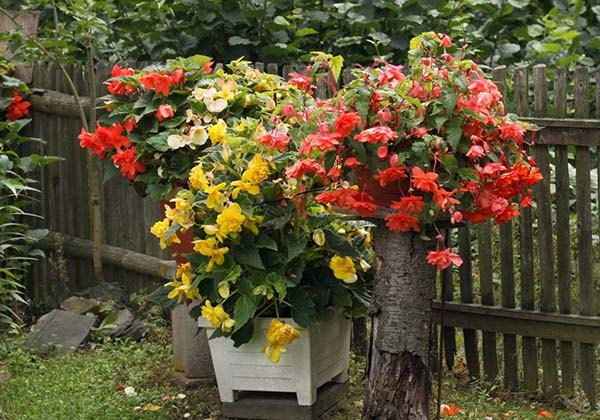
Content
Types of begonias
There are 3 main types of begonias:
- decorative leafy (Royal);
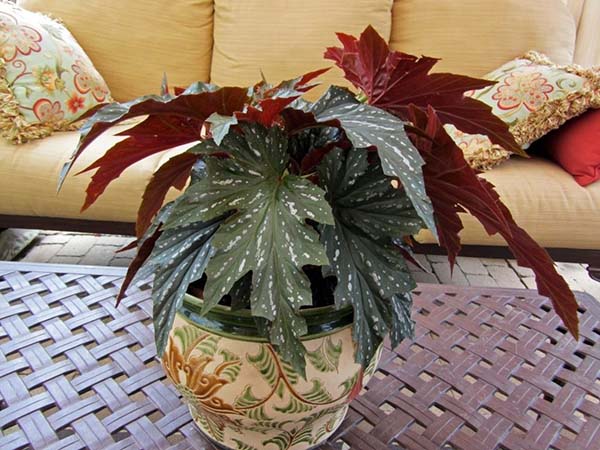
- bush (Coral);
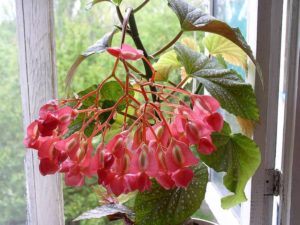
- tuberous (ever flowering).
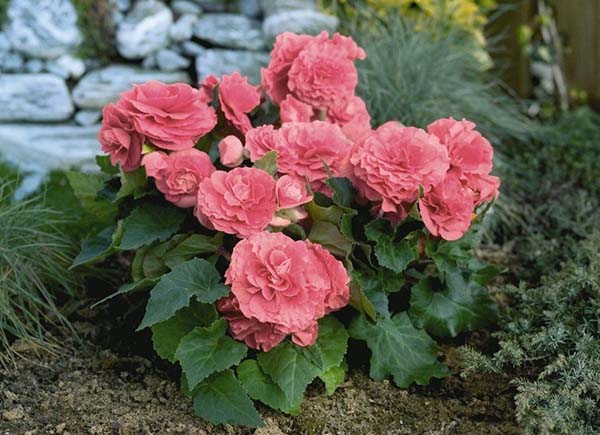
Among the most popular varieties of tuberous (ever-flowering) begonia are the following: Camellia, Marmorata, Samba, Alkor, Pikoti, Ampelnaya.
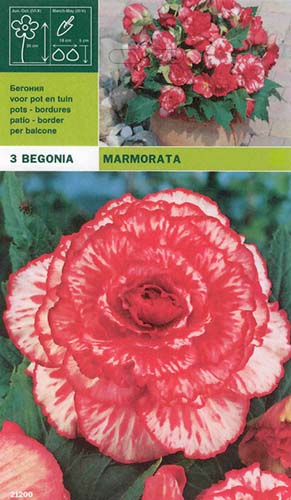 As a rule, only tuberous begonias are grown in the open field in the garden, the remaining varieties (deciduous and bushy) are grown at home or indoors.
As a rule, only tuberous begonias are grown in the open field in the garden, the remaining varieties (deciduous and bushy) are grown at home or indoors.
Planting begonia seeds for seedlings
If you cannot find a suitable variety, or it seems to you that the tubers are too expensive, then buy begonia seeds and plant them.
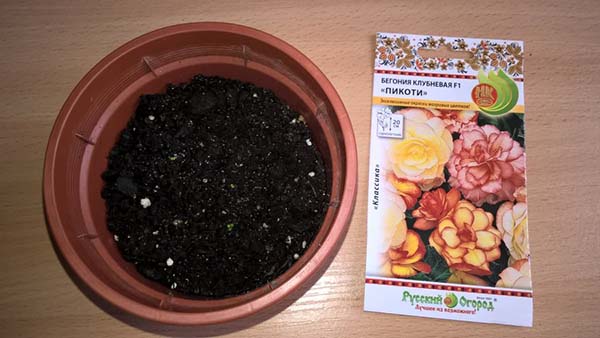
When to plant seedlings
Most often, most gardeners call February the most optimal time for sowing begonia seeds for seedlings. But there are a number of flower growers who start sowing in the second half of January.
However! As in the first (in February), and even more so in the second case (when planting in January), the seedlings will have to actively supplement to a more efficient 12-14 hour daylight hours.
Container and soil
When choosing containers for sowing seeds, we recommend choosing the most common transparent food containers with a lid, in which salads or cakes are sold in stores.
Many budding growers would like to grow begonias from seeds in peat tablets. It is both easier and more reliable.

The soil for planting begonias requires light and nutritious, it should include the following components: high peat, deciduous soil and humus.
Another proven recipe for making begonia potting mix is the following: 1 part high peat, 1 part turf and 1 part leaf and handful wood ash.
Whatever soil you make, further, it must be sieved and disinfect in one way (for example, steam in an oven or microwave).
Sowing
Step-by-step instructions for sowing begonia seeds for seedlings:
- Pour some water into the planting container.
- Fill the container with soil, dumping it directly onto the water and slightly pressing it in, and then sprinkle it with plenty of water from the top of the spray bottle so that the soil is moistened as much as possible.
- Since begonia seeds are very small, they do not need to be buried. They just need to be carefully laid out or scattered over the surface of the soil, for example, by mixing with sand or using a toothpick.
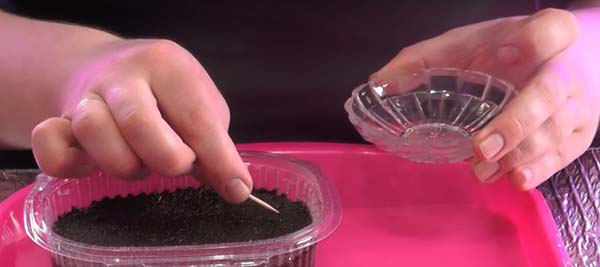
- After spreading the seeds, you should gradually moisten them from above from a spray bottle (or fine spray), so that the contact of the seeds with the soil is even better.
- Cover the container with a lid or cover it with plastic (shoe cover will also work) and place in a bright and warm place. The optimum temperature for seed germination is 20-25 degrees.
If you want to use an easier way to grow begonias from seeds in peat tablets, then watch the next video.
Video: winter sowing of tuberous begonia in peat tablets
Care after planting seedlings
The first shoots usually take 2 weeks to appear. At this time, it is required to check the moisture content of the soil and remove condensation from the shelter.
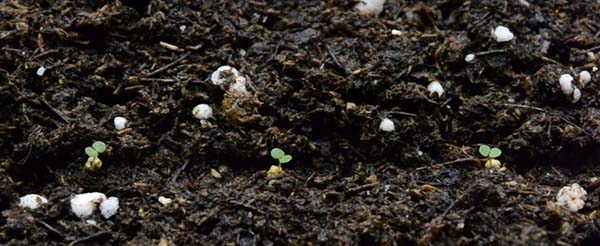
As soon as shoots appear, the shelter can be removed.
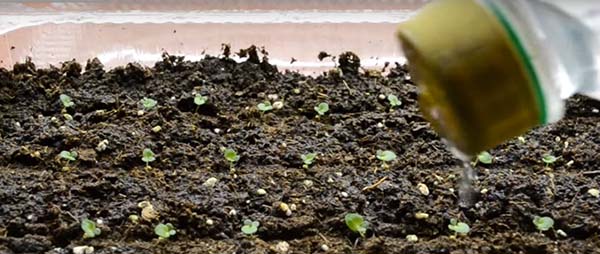
Now you should begin to gently water the young begonia seedlings, if possible, without hitting the plants themselves.
Note! Begonia grows very slowly.
Picking
The picking of begonia seedlings is carried out about 2 months after sowing, when 2-3 true leaves are formed in the plant.
According to some gardeners, the seedlings of this flower require as many as 3 picks. The first, when the plant has 2 leaves, at a distance of 2 by 2 cm, the second time - 5 by 5 cm, the third - 7 by 7 cm.But this is not at all necessary, it is enough to plant the plants in separate ones in the phase of 2 true leaves capacity.
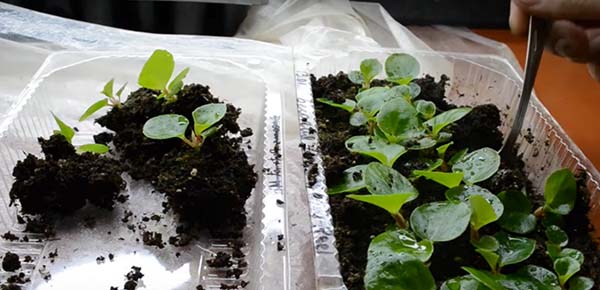
Picking a begonia is no different from picking any other plant. Simply take out a seedling with a lump of earth with a spoon or any other device (for example, tweezers) and bury it in a prepared hole in the planting container.
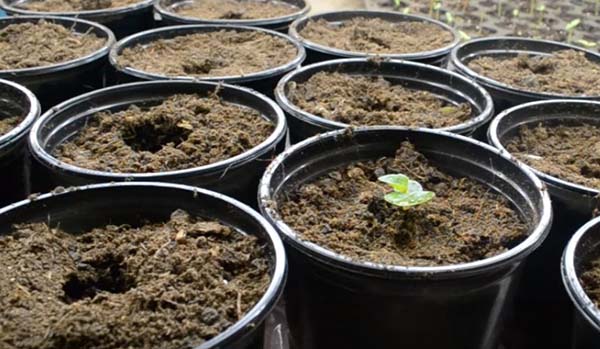
Begonia tolerates picking perfectly and almost painlessly. The main thing is to do everything carefully, without sudden movements and not to damage the roots.
Video: picking begonia
Further care for begonia consists in regular watering as the soil dries up and feeding.
Since this is a heat-loving plant, the temperature should be at least 18 degrees.
The plant is very demanding on the soil and needs additional nutrition, especially if you planted it in insufficiently nutritious soil. It is desirable to use liquid biohumus as a top dressing, for example, Gumistar.
7 days after the pick, it is advisable to feed the begonia with nitrogen fertilizer or some weak organic fertilizer to build up green mass.
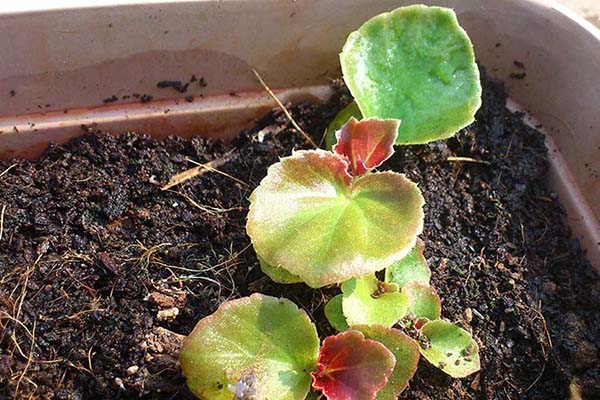
Note! The root system of the plant is superficial, so it is impossible for the soil to dry out completely, otherwise the plant will die.
When the begonia is old enough, you can continue to grow it at home or transplant it to the garden bed.
Planting begonia seedlings in open ground
Before planting seedlings, it is recommended to pre-harden it for 7-10 days so that the begonia weaned from home growing conditions and got used to the street and open air.
The moment of planting begonia seedlings in open ground comes when the threat of return frosts has passed, that is, somewhere in mid-late May.
The flower will grow well only on light and fertile soils. This is due to the fact that the roots of the plant are rather shallow, they are located in the upper layers of the soil, so the flower needs a loose and nutritious soil.
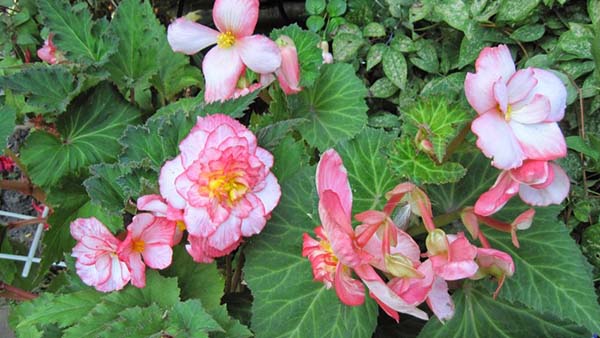
Ever-flowering begonia loves sunny places, so it is advisable to plant it in the beds, where the sun is all day long. Although, according to some gardeners, it can grow well in light partial shade.
The distance between plantings, in other words, the planting pattern of begonias differs depending on the variety: undersized plants are planted at a distance of 15-20 centimeters from each other, and tall ones - 30-40 cm.
The process of planting begonia seedlings is quite simple: you need to lower the plant into a previously prepared small hole along with an earthen clod and sprinkle it with earth on top. And also slightly press down so that the plant does not move during watering.

The next required step is mulching. This is due to the fact that the plant is very fragile, and its root system needs additional protection so that during watering the roots do not erode. Also, mulch is additional oxygen and protection from drying out.

Now it remains only to water the plantings from a garden watering can.
Video: growing evergreen begonias from seeds and care
Growing begonias through tubers
Tubers should be purchased in late February - early March. The optimal time for planting begonias with tubers is March.
Advice! If you want nothing to happen to the tubers during transportation, be sure to wrap the package in newspaper and additionally put it in a plastic bag so that they do not freeze.
If you have saved begonia tubers in winter, then in March they should be taken out of storage and start preparing them for planting.
Processing tubers before planting
Firstly, if possible, it is necessary to remove dry roots from the convex part, so that the tuber is clean and better treated with preparations (you can do this with your hands or with scissors).
After cleaning, you should start processing the begonia tubers, more precisely, to dressing them.
You can pickle the tubers in one of the fungicides, for example, in "Augustine for pickling planting material" (consumption - 2 ml of agent per 1 liter of water). You need to keep the tubers in a warm solution for 20-40 minutes.
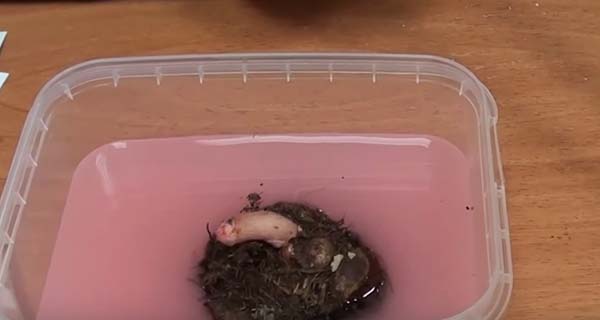
Advice! It is highly recommended that the tubers are not completely in the water, but about half. The upper part where the kidney is located should not be in water.
Additionally, you can soak the tubers in a growth stimulator, for example, in Epin (consumption of 1-2 drops of the product per 1 glass of water).
Capacity and soil mixture
The container for growing begonias from tubers should not be high, because all the roots of the plant are on the surface and do not go deep into the ground. If you take a deep container, then moisture will stagnate below, and the soil may turn sour.In other words, the container should be wider than tall.
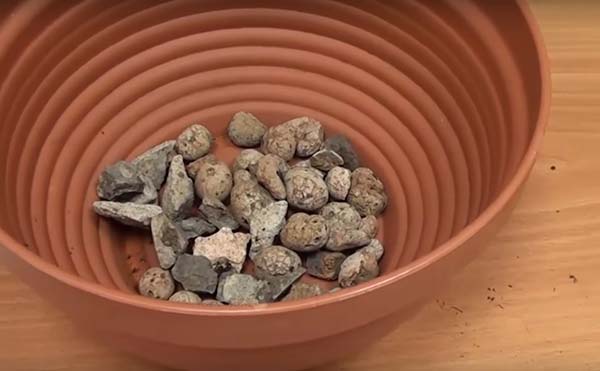
Important! Drainage is required for begonias. To do this, you can use expanded clay, gravel or brick fragments.
The land must be loose and of high quality. The main thing is that there is a lot of air in the soil, in other words, it must be very breathable.
You can buy ready-made special soil for begonias in a garden store or prepare it yourself according to the recipe below. In general, it is completely identical to the soil for planting seeds, which, in fact, is not surprising.
Recipe for potting soil mix for planting begonia tubers:
- 2 pieces of leafy land;
- 1 part of humus;
- 1 part sand;
- 1 part high peat.
As with preparing the ground for planting seeds, the soil mixture needs to be sieved well and disinfect.
Landing
Step-by-step method of planting begonia tubers:
- Make good drainage.
- Fill the container with soil and do not compact (the earth itself will compact during watering), just level it slightly.
- It is necessary to plant begonias tubers with the convex part down, and the concave part up (not the other way around!), Because buds are formed precisely from the concave side (where the stump is from the past stem). As in the case of pickling, it is necessary to bury the tuber approximately halfway into the ground so that the upper part, where the bud is located, is not in the ground, otherwise it can rot.
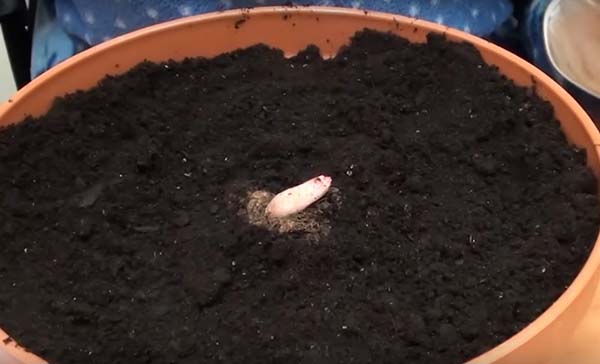
- After that, you should shed the soil around the tuber with a solution phytosporin (according to the instructions) for disinfection). Moreover, it is advisable to do this at the edges, and not next to the plant.
- Cover with a lid or plastic bag. But some gardeners do not recommend covering the planting if your room is already hot enough and high humidity.
- Place in a warm and bright place.
Video: how to plant tuberous begonia
Plant care after planting
Begonias usually begin to germinate after a couple of weeks.
Further, it is necessary to ensure that the soil does not dry out and water as needed, but not overflow.

Begonia responds very well to long-term fertilization, so that, unlike one-time fertilization, they are gradually and evenly distributed, and the plant receives nutrients with each watering.
Planting seedlings in the garden
As in the case of seedlings, which were grown from seeds, plant begonias from tubers in open ground as soon as the threat of return spring frosts has passed, in other words, starting from the middle of May, after having previously hardened.
The place for begonias is chosen sunny. The soil should be fertile, loose and breathable.
The depth of the planting hole should correspond to the size of the seedling root system.
The scheme for planting begonias in open ground: low-growing plants are planted at a distance of 15-20 centimeters from each other, and tall ones - 30-40 cm.
After planting, the plant should be well mulched and watered.
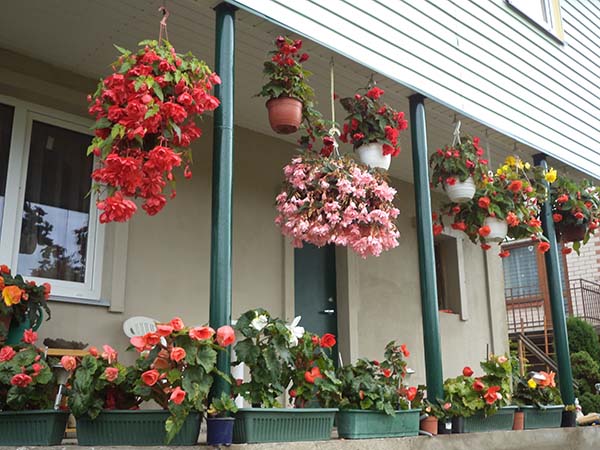
Advice! It will be very beautiful if you decorate your summer cottage with hanging pots with begonias.
Further care in the garden for begonias grown from tubers completely coincides with care when growing from seeds.
The only difference is that such plants bloom a couple of weeks earlier.
Outdoor begonia care
What should be included in the subsequent care of begonias is loosening and weeding (there should not be weeds!), Watering as needed (the soil should not dry out) and feeding depending on the state of the plant (plant stuntedness is a consequence of a lack of nutrients).
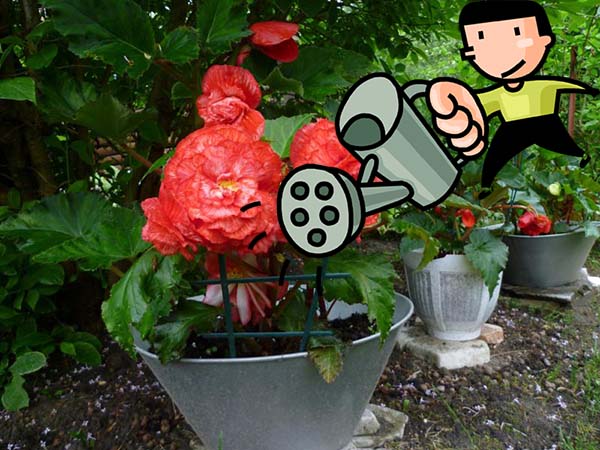
To water begonia is recommended either early in the morning or in the evening after sunset. Preferably warm water.
If the weather is not sunny, then watering should be carried out no more than 1 time a week.
On hot days - every evening at the root, without getting on the leaves and flowers.
Top dressing young begonia seedlings can be done as follows: fertilize 2 times a month potassium humate, 2 times - any potassium-phosphorus fertilizer.An adult flower is usually fertilized with a complex mineral fertilizer once a month. With the onset of autumn, feeding is stopped.
As a rule, begonia blooms in about a month and a half after planting seedlings in the beds, that is, it usually occurs at the end of June - beginning of August. The peak of flowering is mid-August.
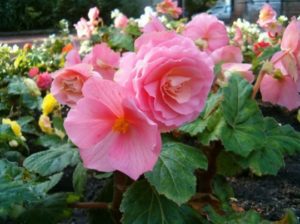
If you grow a tall begonia, then during its flowering period it will not be superfluous tie it to the supportso that the plant does not break off the stem under the oppression of a huge number of flowers.
As it blooms flowers are best removedto prevent the plant from setting seeds.
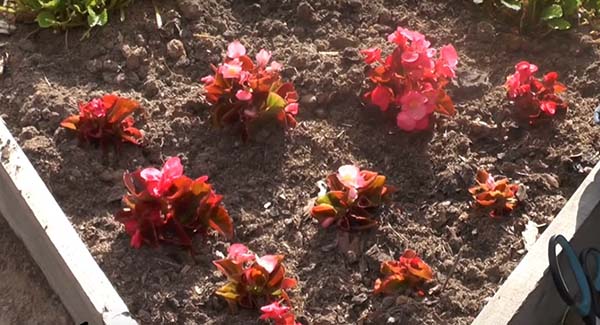
If you notice that the subsequent flowers become smaller and even turn pale, then you should definitely feed complex mineral fertilizer. And if organic matter has not been previously introduced into the soil, then you can use a small amount of compost, carefully placing a handful of fertilizers under each bush, thereby mulching the plant.
When the top of the plant is completely dry, you should dig up his tubers, clean them of the earth and disinfect them by treating them with one of the fungicides (as an option, potassium permanganate is suitable). Then dry and put in a bag of sphagnum moss or in a container with sand. After that, put the young begonia tubers for winter storage in the basement, where the temperature is kept around 5 degrees.
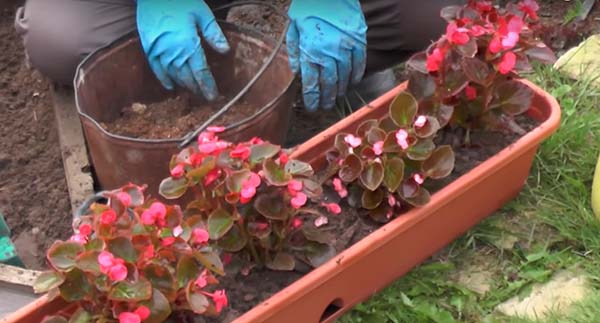
If you want to grow begonia as a perennial, then with the onset of cold weather, you can dig up and transplant the plant into a pots, balcony box or any other flower pot and continue growing it at home. And next spring, when the threat of frost passes, you can plant an already blooming begonia in a permanent place in the garden, thereby organizing a blooming flower bed in your country house in mid-May.
Thus, growing a relatively capricious, but insanely beautiful begonias can only be done by making efforts to care for these beautiful flowers. If you do everything correctly and do not make the mistakes typical of novice gardeners, then it will certainly delight you with its magnificent flowering and aroma.

